GIGABYTE GA-945PL-DS3 Owner's Manual

GA-945PL-DS3/ GA-945PL-S3 (rev. 2.0)
Intel® CoreTM 2 Extreme dual-core / CoreTM 2 Duo /
Intel® Pentium® D / Pentium® 4 / Celeron® D LGA775 Processor Motherboard
User's Manual
Rev. 2002
12ME-945PLDS3-2002R
*The WEEE marking on the product indicates this product must not be disposed of with user's other household waste and must be handed over to a designated collection point for the recycling of waste electrical and electronic equipment!!
*The WEEE marking applies only in European Union's member states.
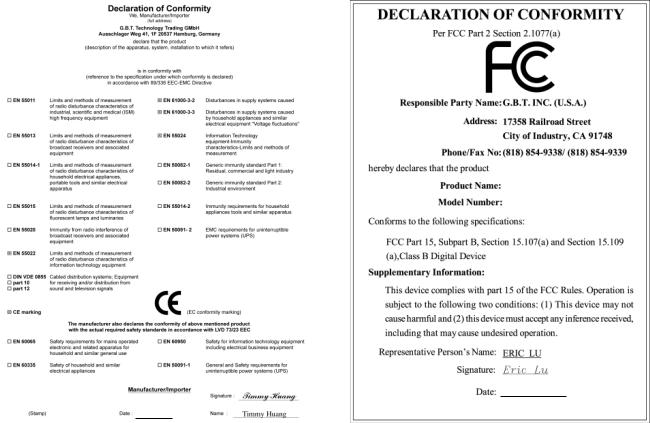
Motherboard
GA-945PL-DS3/GA-945PL-S3 (rev. 2.0)
Motherboard
GA-945PL-DS3/
GA-945PL-S3 (rev. 2.0)
Oct. 25, 2006
Oct. 25, 2006

Copyright
© 2006 GIGA-BYTE TECHNOLOGY CO., LTD. All rights reserved.
The trademarks mentioned in the manual are legally registered to their respective companies.
Notice
The written content provided with this product is the property of Gigabyte.
No part of this manual may be reproduced, copied, translated, or transmitted in any form or by any means without Gigabyte's prior written permission. Specifications and features are subject to change without prior notice.
Product Manual Classification
In order to assist in the use of this product, Gigabyte has categorized the user manual in the following:
For quick installation, please refer to the "Hardware Installation Guide" included with the product.
For detailed product information and specifications, please carefully read the
"Product User Manual".
For detailed information related to Gigabyte's unique features, please go to the "Technology Guide" section on Gigabyte's website to read or download the information you need.
For more product details, please visit Gigabyte's website at www.gigabyte.com.tw

Table of Contents
ItemChecklist ................................................................................................................. |
|
6 |
OptionalAccessories ...................................................................................................... |
6 |
|
GA-945PL-DS3/GA-945PL-S3 (rev. 2.0) Motherboard Layout ...................................... |
7 |
|
Block Diagram ................................................................................................................ |
|
8 |
Chapter 1 Hardware Installation .................................................................................... |
9 |
|
1-1 |
Considerations Prior to Installation .................................................................... |
9 |
1-2 |
Feature Summary .......................................................................................... |
10 |
1-3 |
Installation of the CPU and CPU Cooler ....................................................... |
12 |
1-3-1 Installation of the CPU ......................................................................................... |
12 |
|
1-3-2 Installation of the Cooler ...................................................................................... |
13 |
|
1-4 |
Installation of Memory .................................................................................... |
14 |
1-5 |
Installation of Expansion Cards ...................................................................... |
16 |
1-6 |
I/O Back Panel Introduction ........................................................................... |
17 |
1-7 |
Connectors Introduction .................................................................................. |
18 |
Chapter 2 BIOS Setup ................................................................................................ |
29 |
|
The Main Menu (For example: GA-945PL-DS3 BIOS Ver.: F1a) ............................. |
30 |
|
2-1 |
Standard CMOS Features ............................................................................. |
32 |
2-2 |
Advanced BIOS Features .............................................................................. |
34 |
2-3 |
Integrated Peripherals ..................................................................................... |
36 |
2-4 |
Power Management Setup ............................................................................. |
39 |
2-5 |
PnP/PCI Configurations ................................................................................. |
41 |
2-6 |
PC Health Status ........................................................................................... |
42 |
2-7 |
MB Intelligent Tweaker(M.I.T.) ....................................................................... |
44 |
2-8 |
Load Fail-Safe Defaults ................................................................................... |
47 |
2-9 |
Load Optimized Defaults ................................................................................. |
47 |
2-10 |
Set Supervisor/User Password ..................................................................... |
48 |
2-11 |
Save & Exit Setup ......................................................................................... |
49 |
2-12 |
Exit Without Saving ....................................................................................... |
49 |
- 4 -

Chapter 3 Install Drivers ............................................................................................. |
51 |
|
3-1 |
Install Chipset Drivers .................................................................................... |
51 |
3-2 |
SoftwareApplications ..................................................................................... |
52 |
3-3 |
Driver CD Information .................................................................................... |
52 |
3-4 |
Hardware Information ..................................................................................... |
53 |
3-5 |
Contact Us ..................................................................................................... |
53 |
Chapter 4 Appendix ................................................................................................... |
55 |
||
4-1 |
Unique Software Utilities ................................................................................ |
55 |
|
|
4-1-1 |
EasyTune 5 Introduction ..................................................................................... |
55 |
|
4-1-2 |
Xpress Recovery2 Introduction ......................................................................... |
56 |
|
4-1-3 |
Flash BIOS Method Introduction ........................................................................ |
58 |
|
4-1-4 |
2- / 4- / 6- / 8- Channel Audio Function Introduction ...................................... |
67 |
4-2 |
Troubleshooting ............................................................................................... |
72 |
|
- 5 -

Item Checklist
 IDE Cable x 1, FDD Cable x 1
IDE Cable x 1, FDD Cable x 1
 SATA 3Gb/s Cable x 2
SATA 3Gb/s Cable x 2
I/O Shield
* The items listed above are for reference only, and are subject to change without notice.
Optional Accessories
2 Ports USB 2.0 Cable (Part Number: 12CR1-1UB030-51/R)
4 Ports USB 2.0 Cable (Part Number: 12CR1-1UB030-21/R)
SPDIF In and Out Cable (Part Number: 12CR1-1SPINO-11/R)
e-SATA Cable (Part Number: 12CF1-3SATPW-11R)
- 6 -
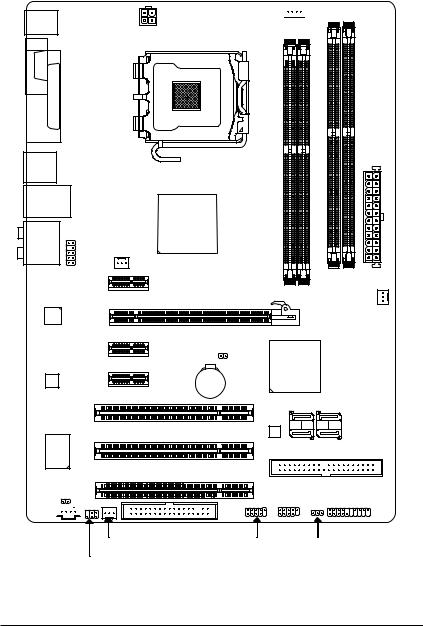
GA-945PL-DS3/GA-945PL-S3 (rev. 2.0) Motherboard Layout
KB_MS |
ATX_12V |
|
LGA775
COMA
LPT
USB
USB_LAN
Intel® 945PL
F_AUDIO
AUDIO
NB_FAN
PCIE_3
RTL 8111B
CPU_FAN 


-945PL-S3 |
|
DS3/GA-945PL-GA |
ATX |
|
DDRII1 |
DDRII2 |
DDRII3 |
DDRII4 |
PCIE_16
PWR_FAN
|
PCIE_1 |
CLR_CMOS |
|
|
|
|
|
Intel® ICH7 |
|
CODEC |
PCIE_2 |
BATTERY |
|
|
|
|
PCI1 |
SATAII0 |
|
|
|
|
|
|
|
|
|
BIOS |
SATAII2 |
|
|
|
|
|
IT8718 |
|
PCI2 |
SATAII1 |
SATAII3 |
|
|
|||
|
|
IDE1 |
||
|
|
|
||
|
|
|
|
2.0 |
|
REV: |
CI |
|
CD_IN 
PCI3 |
|
F_USB2 |
F_PANEL |
FDD |
|
SYS _FAN |
F_USB1 |
PWR_LED |
SPDIF_IO
- 7 -
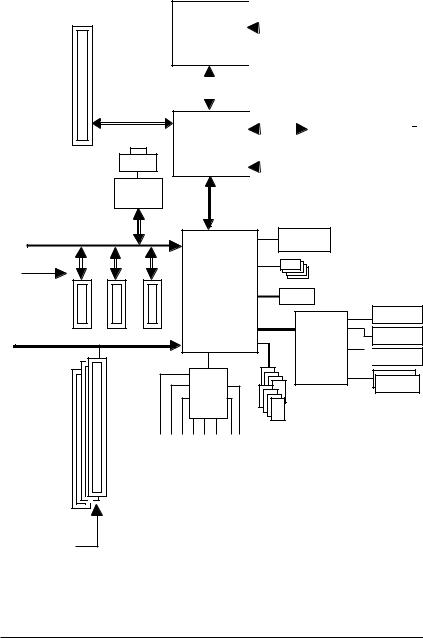
Block Diagram
PCIe CLK
(100 MHz)
PCI Express x16
RJ45
RTL 8111B
x 1
PCI Express Bus
x 1 |
x 1 |
x 1 |
PCIe CLK
(100 MHz)
3 PCI Express x1
PCI Bus |
|
|
Speaker Out Speaker Out |
3 PCI |
Surround Center/Subwoofer |
|
|
PCI CLK |
|
(33 MHz) |
|
LGA775 |
|
|
CPU CLK+/-(200/133 MHz) |
|||||||||||
|
|
|
|
|
|
|
|
|
|
|
|
|
||
Processor |
|
|
|
|
|
|
|
|
|
|
|
|
|
|
|
|
|
|
|
|
|
|
|
|
|
|
|
|
|
|
Host |
|
|
|
|
|
|
|
|
|
|
|
||
|
|
|
|
|
|
|
|
|
|
|
|
|||
|
Interface |
|
DDRII 400/533 MHz DIMM |
|||||||||||
|
|
|
|
|
||||||||||
|
|
|
|
|||||||||||
Intel® |
|
|
|
|
|
|
|
Dual Channel Memory |
|
|
|
|||
|
|
|
|
|
|
|
|
|
|
|||||
|
|
|
|
|
|
|
|
|
|
|||||
945PL |
|
|
|
|
|
|
|
|
|
|
|
|
|
|
|
|
|
|
|
|
|
|
|
|
|
||||
|
|
|
|
|
|
|
|
|
|
|
||||
|
|
|
|
MCH CLK(200/133 MHz) |
|
|
|
|||||||
|
|
|
|
|||||||||||
Intel®
ICH7
CODEC
SPDIF Out
SPDIF In
Line-In
Line-Out
MIC
Side Speaker Out
BIOS
4 SATA 3Gb/s
ATA33/66/100
IDE1 Channel
Floppy
LPT Port
IT8718

 COM Port
COM Port
PS/2 KB/Mouse
8 USB
Ports
- 8 -

Chapter 1Hardware Installation
1-1 Considerations Prior to Installation
Preparing Your Computer
The motherboard contains numerous delicate electronic circuits and components which can become damaged as a result of electrostatic discharge (ESD). Thus, prior to installation, please follow the instructions below:
1.Please turn off the computer and unplug its power cord.
2.When handling the motherboard, avoid touching any metal leads or connectors.
3.It is best to wear an electrostatic discharge (ESD) cuff when handling electronic components (CPU, RAM).
4.Prior to installing the electronic components, please have these items on top of an antistatic pad or within a electrostatic shielding container.
5.Please verify that the power supply is switched off before unplugging the power supply connector from the motherboard.
Installation Notices
1.Prior to installation, please do not remove the stickers on the motherboard. These stickers are required for warranty validation.
2.Prior to the installation of the motherboard or any hardware, please first carefully read the information in the provided manual.
3.Before using the product, please verify that all cables and power connectors are connected.
4.To prevent damage to the motherboard, please do not allow screws to come in contact with the motherboard circuit or its components.
5.Please make sure there are no leftover screws or metal components placed on the motherboard or within the computer casing.
6.Please do not place the computer system on an uneven surface.
7.Turning on the computer power during the installation process can lead to damage to system components as well as physical harm to the user.
8.If you are uncertain about any installation steps or have a problem related to the use of the product, please consult a certified computer technician.
Instances of Non-Warranty
1.Damage due to natural disaster, accident or human cause.
2.Damage as a result of violating the conditions recommended in the user manual.
3.Damage due to improper installation.
4.Damage due to use of uncertified components.
5.Damage due to use exceeding the permitted parameters.
6.Product determined to be an unofficial Gigabyte product.
English
- 9 - |
Hardware Installation |

English
1-2 |
Feature Summary |
||
|
|
|
|
CPU |
|
|
LGA775 for Intel® CoreTM 2 Extreme dual-core / CoreTM 2 Duo / Pentium® D / |
|
|
|
Pentium® 4 / Celeron® D |
|
|
L2 cache varies with CPU |
|
Front Side Bus |
|
Supports 800/533 MHz FSB |
|
Chipset |
|
|
Northbridge: Intel® 945PL Express Chipset |
|
|
|
Southbridge: Intel® ICH7 |
LAN |
|
|
Onboard RTL8111B chip (10/100/1000Mbit) |
Audio |
|
|
Onboard Realtek ALC888 CODEC chip |
|
|
Supports High Definition Audio |
|
|
|
Supports 2 / 4 / 6 / 8 channel audio |
|
|
|
Supports S/PDIF In/Out connection |
|
|
|
Supports CD In connection |
|
Storage |
|
|
Intel® ICH7 |
|
|
|
- 1 FDD connector, allowing connection of 1 FDD devices |
|
|
|
- 1 IDE connector with UDMA 33/ATA 66/ATA 100 support, |
|
|
|
allowing connection of 2 IDE devices |
|
|
|
- 4 SATA 3Gb/s connectors, |
|
|
|
allowing connection of 4 SATA 3Gb/s devices |
|
|
|
|
O.S Support |
|
Microsoft Windows 2000/XP |
|
Memory |
|
|
4 DDRII DIMM memory slots (supports up to 2 GB memory) |
|
|
Supports dual channel DDRII 533(Note 1)/400 DIMMs |
|
|
|
Supports 1.8V DDRII DIMMs |
|
Expanstion Slots |
|
1 PCI Express x16 slot |
|
|
|
3 PCI Express x1 slots |
|
|
|
|
3 PCI slots |
Internal Connectors |
|
1 24-pin ATX power connector |
|
1 4-pin ATX 12V power connector
1 floppy connector
1 IDE connector
4 SATA 3Gb/s connectors
1 CPU fan connector
1 system fan connector
1 power fan connector
1 northbridge fan connector
1 front panel connector
1 front audio connector
1 CD In connector
1 S/PDIF In/Out connector
2 USB 2.0/1.1 connectors for additional 4 USB 2.0/1.1 ports by cables
1 power LED connector
1 Chassis Intrusion connector
"*" Only the GA-945PL-DS3 adopts All-Solid Capacitor design.
GA-945PL-(D)S3 (rev. 2.0) Motherboard |
- 10 - |

Rear Panel I/O |
|
1 PS/2 keyboard port |
|
1 PS/2 mouse port |
|
|
|
1 parallel port |
|
|
1 serial port |
|
4 USB 2.0/1.1 port |
|
|
|
1 RJ-45 ports |
|
6 audio jacks (Line In / Line Out / MIC In/Surround Speaker Out (Rear |
|
|
|
Speaker Out)/Center/Subwoofer Speaker Out/Side Speaker Out) |
I/O Control |
|
IT8718 chip |
Hardware Monitor |
|
System voltage detection |
|
|
CPU temperature detection |
|
CPU / Power / System fan speed detection |
|
|
|
CPU warning temperature |
|
CPU / Power / System fan failure warning |
|
|
Supports CPU Smart Fan function |
|
|
|
|
BIOS |
|
1 4 Mbit flash ROM |
|
Use of licensed AWARD BIOS |
|
Additional Features |
|
Supports @BIOS |
|
|
Supports Download Center |
|
|
Supports Q-Flash |
|
Supports EasyTune(Note 2) |
|
|
|
Supports Xpress Install |
|
|
Supports Xpress Recovery2 |
|
Supports Xpress BIOS Rescue |
|
Bundle Software |
|
Norton Internet Security (OEM version) |
Form Factor |
|
ATX form factor; 30.5cm x 19.3cm |
(Note 1) Some memory configurations will result in memory frequency being reduced from 533 MHz down to 400 MHz. (Please refer to to Page 15 for more information.)
(Note 2) EasyTune functions may vary depending on different motherboards.
English
- 11 - |
Hardware Installation |

English
1-3 Installation of the CPU and CPU Cooler
Before installing the CPU, please comply with the following conditions:
1.Please make sure that the motherboard supports the CPU.
2. Please take note of the one indented corner of the CPU. If you install the CPU in the wrong direction, the CPU will not insert properly. If this occurs, please change the insert direction of the CPU.
3.Please add an even layer of heat sink paste between the CPU and CPU cooler.
4.Please make sure the CPU cooler is installed on the CPU prior to system use, otherwise overheating and permanent damage of the CPU may occur.
5.Please set the CPU host frequency in accordance with the processor specifications. It is not recommended that the system bus frequency be set beyond hardware specifications since it does not meet the required standards for the peripherals. If you wish to set the frequency beyond the proper specifications, please do so according to your hardware specifications including the CPU, graphics card, memory, hard drive, etc.
HT functionality requirement content :
Enabling the functionality of Hyper-Threading Technology for your computer system requires all of the following platform components:
-CPU: An Intel® Pentium 4 Processor with HT Technology
-Chipset: An Intel® Chipset that supports HT Technology
-BIOS: A BIOS that supports HT Technology and has it enabled
-OS: An operation system that has optimizations for HT Technology
1-3-1 Installation of the CPU
Metal Lever |
Fig. 1 |
Fig. 2 |
|
Gently lift the metal |
Remove the plastic |
||
|
|||
|
lever located on the |
covering on the CPU |
|
|
CPU socket to the |
socket. |
|
|
upright position. |
|
|
|
Fig. 3 |
Fig. 4 |
|
|
Notice the small gold |
Once the CPU is |
|
|
colored triangle |
properly inserted, |
|
|
located on the edge of |
please replace the |
|
|
the CPU socket. |
load plate and push the |
|
|
Align the indented |
metal lever back into |
|
|
|
its original position. |
corner of the CPU with the triangle and gently insert the CPU into position. (Grasping the CPU firmly between your thumb and forefinger, carefully place it into the socket in a straight and downwards motion. Avoid twisting or bending motions that might cause damage to the CPU during installation.)
GA-945PL-(D)S3 (rev. 2.0) Motherboard |
- 12 - |

1-3-2 Installation of the Cooler
Male Push Pin
 The top of Female Push Pin
The top of Female Push Pin
Female Push Pin
Fig.1
Please apply an even layer of CPU cooler paste on the surface of the installed CPU.
Fig. 3
Place the CPU cooler atop the CPU and make sure the push pins aim to the pin hole on the motherboard.Pressing down the push pins diagonally.
Fig. 5
Please check the back of motherboard after installing. If the push pin is inserted as the picture, the installation is complete.
Fig. 2
(Turning the push pin along the direction of arrow is to remove the CPU cooler, on the contrary, is to install.) Please note the direction of arrow sign on the male push pin doesn't face inwards before installation. (This instruction is only for Intel boxed fan)
Fig. 4
Please make sure the Male and Female push pin are joined closely. (for detailed installation instructions, please refer to the CPU cooler installation section of the user manual)
Fig. 6
Finally, please attach the power connector of the CPU cooler to the CPU fan header located on the motherboard.
The CPU cooler may adhere to the CPU as a result of hardening of the heat paste. To prevent such an occurrence, it is suggested that either thermal tape rather than heat paste be used for heat dissipation or using extreme care when removing the CPU cooler.
English
- 13 - |
Hardware Installation |
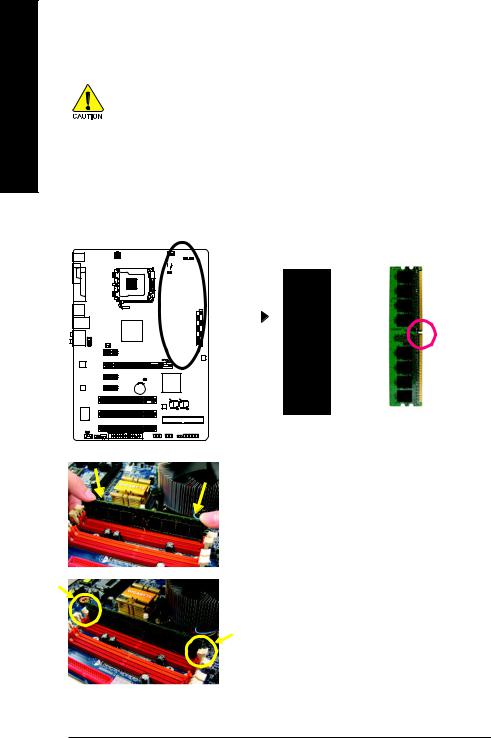
English
1-4 Installation of Memory
Before installing the memory modules, please comply with the following conditions:
1.Please make sure that the memory used is supported by the motherboard. It is
recommended that memory of similar capacity, specifications and brand be used.
2.Before installing or removing memory modules, please make sure that the computer power is switched off to prevent hardware damage.
3.Memory modules have a foolproof insertion design. A memory module can be installed in only one direction. If you are unable to insert the module, please switch the direction.
The motherboard supports DDRII memory modules, whereby BIOS will automatically detect memory capacity and specifications. Memory modules are designed so that they can be inserted only in one direction. The memory capacity used can differ with each slot.
Notch
DDRII
Fig.1
The DIMM socket has a notch, so the DIMM memory module can only fit in one direction. Insert the DIMM memory module vertically into the DIMM socket. Then push it down.
Fig.2
Close the plastic clip at both edges of the DIMM sockets to lock the DIMM module.
Reverse the installation steps when you wish to remove the DIMM module.
GA-945PL-(D)S3 (rev. 2.0) Motherboard |
- 14 - |

Dual Channel Memory Configuration
GA-945PL-DS3/GA-945PL-S3 supports the Dual Channel Technology. After
operating the Dual Channel Technology, the bandwidth of Memory Bus will
add double.
GA-945PL-DS3/GA-945PL-S3 includes 4 DIMM sockets, and each Channel has two DIMM sockets as following:
Channel 0 : DDRII1, DDRII2
Channel 1 : DDRII3, DDRII4
If you want to operate the Dual Channel Technology, please note the following explanations due to the limitation of Intel chipset specifications.
1.Dual Channel mode will not be enabled if only one/three DDRII memory module is installed.
2.To enable Dual Channel mode with two or four memory modules (it is recommended to use memory modules of identical brand, size, chips, and speed), install the memory according to the dual channel memory configuration table below (Figure 1).
Dual Channel Memory Configuration Table (DS: Double Side, SS: Single Side, X: Empty)
|
DDRII1 |
DDRII2 |
DDRII3 |
DDRII4 |
2 memory modules |
DS/SS |
X |
DS/SS |
X |
|
DS/SS |
X |
X |
DS/SS |
|
X |
DS/SS |
DS/SS |
X |
|
X |
DS/SS |
X |
DS/SS |
4 memory modules |
SS |
SS |
SS |
SS |
|
|
|
|
|
Figure 1
Memory configurations in Figure 2 will result in memory frequency being reduced from 533MHz down to 400MHz. (DS: Double Side, SS: Single Side, X: Empty)
|
DDRII1 |
DDRII2 |
DDRII3 |
DDRII4 |
2 memory modules |
SS |
SS |
X |
X |
|
X |
X |
SS |
SS |
3 memory modules |
SS |
SS |
DS/SS |
X |
|
SS |
SS |
X |
DS/SS |
|
DS/SS |
X |
SS |
SS |
|
X |
DS/SS |
SS |
SS |
4 memory modules |
SS |
SS |
SS |
SS |
|
|
|
|
|
Figure 2
Because of chipset limitations, do not populate both DIMM sockets of the same channel with double-sided memory modules to prevent system's failure to start or incorrect detection of memory modules,
English
- 15 - |
Hardware Installation |
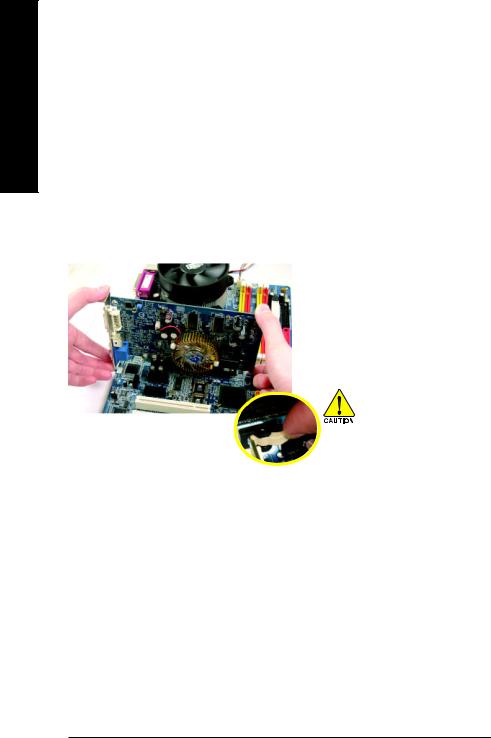
English
1-5 Installation of Expansion Cards
You can install your expansion card by following the steps outlined below:
1.Read the related expansion card's instruction document before install the expansion card into the computer.
2.Remove your computer's chassis cover, screws and slot bracket from the computer.
3.Press the expansion card firmly into expansion slot in motherboard.
4.Be sure the metal contacts on the card are indeed seated in the slot.
5.Replace the screw to secure the slot bracket of the expansion card.
6.Replace your computer's chassis cover.
7.Power on the computer, if necessary, setup BIOS utility of expansion card from BIOS.
8.Install related driver from the operating system.
Installing a PCI Express x16 expansion card:
Please align the VGA card to the onboard PCI Express x16 slot and press firmly down on the slot. Make sure your VGA card is locked by the latch at the end of the PCI Express x16 slot. When you try uninstall the VGA card, please gently press the latch as the picture to the left shows to release the card.
GA-945PL-(D)S3 (rev. 2.0) Motherboard |
- 16 - |
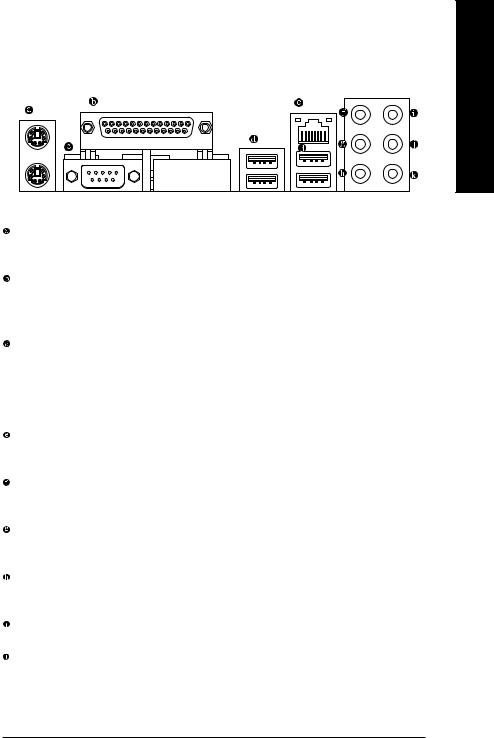
1-6 I/O Back Panel Introduction
English
PS/2 Keyboard and PS/2 Mouse Connector
To install a PS/2 port keyboard and mouse, plug the mouse to the upper port (green) and the keyboard to the lower port (purple).
LPT (Parallel Port)
The parallel port allows connection of a printer, scanner and other peripheral devices.
 COMA (Serial Port)
COMA (Serial Port)
Devices like mouses, modems, and etc. can be connected to Serial port.
USB Port
Before you connect your device(s) into USB connector(s), please make sure your device(s) such as USB keyboard, mouse, scanner, zip, speaker...etc. have a standard USB interface. Also make sure your OS supports USB controller. If your OS does not support USB controller, please contact OS vendor for possible patch or driver upgrade. For more information please contact your OS or device(s) vendors.
LAN Port
The provided Internet connection is Gigabit Ethernet, providing data transfer speeds of 10/100/ 1000Mbps.
Center/Subwoofer Speaker Out
The default Center/Subwoofer Speaker Out jack. Center/Subwoofer speakers can be connected to Center/Subwoofer Speaker Out jack.
Surround Speaker Out (Rear Speaker Out)
The default Surround Speaker Out (Rear Speaker Out) jack. Rear surround speakers can be connected to Surround Speaker Out (Rear Speaker Out) jack.
Side Speaker Out
The default Side Speaker Out jack. Surround side speakers can be connected to Side Speaker Out jack.
Line In
The default Line In jack. Devices like CD-ROM, walkman etc. can be connected to Line In jack.
Line Out (Front Speaker Out)
The default Line Out (Front Speaker Out) jack. Stereo speakers, earphone or front surround speakers can be connected to Line Out (Front Speaker Out) jack.
- 17 - |
Hardware Installation |
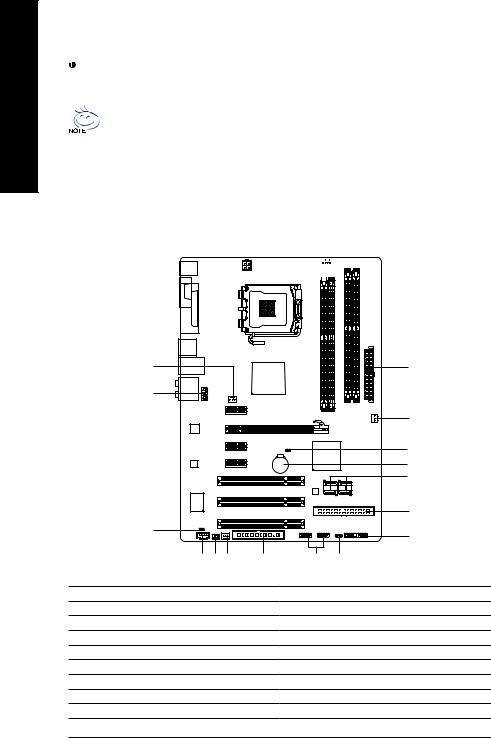
English
MIC In
The default MIC In jack. Microphone must be connected to MIC In jack.
In addition to the default speakers settings, the ~
~ audio jacks can be reconfigured to perform different functions via the audio software. Only microphones still MUST be connected to the default Mic In jack (
audio jacks can be reconfigured to perform different functions via the audio software. Only microphones still MUST be connected to the default Mic In jack ( ). Please refer to the 2-/4-/6-/8- channel audio setup steps for detailed software configuration information.
). Please refer to the 2-/4-/6-/8- channel audio setup steps for detailed software configuration information.
1-7 Connectors Introduction
1 |
3 |
||
|
|
|
|
|
|
|
|
|
|
|
|
|
6 |
|
|
|
|
2 |
|
11 |
|
|
|
|
|
|
|
|
|
|
|
5 |
|
|
|
|
|
|
17 |
|
|
|
|
|
|
18 |
|
|
|
|
|
|
9 |
|
|
|
|
|
|
7 |
|
16 |
|
|
|
|
12 |
|
|
|
|
|
|
|
|
13 |
14 |
4 |
8 |
15 |
10 |
1) |
ATX_12V |
|
|
10) |
PWR_LED |
|
2) |
ATX (Power Connector) |
|
|
11) |
F_AUDIO |
|
3) |
CPU_FAN |
|
|
12) |
F_PANEL |
|
4) |
SYS_FAN |
|
|
13) |
CD_IN |
|
5) |
PWR_FAN |
|
|
14) |
SPDIF_IO |
|
6) |
NB_FAN |
|
|
15) |
F_USB1 / F_USB2 |
|
7) |
IDE1 |
|
|
16) |
CI |
|
8) |
FDD |
|
|
17) |
CLR_CMOS |
|
9) |
SATAII0 / 1 / 2 / 3 |
|
|
18) |
BATTERY |
|
GA-945PL-(D)S3 (rev. 2.0) Motherboard |
- 18 - |

1/2) ATX_12V/ATX (Power Connector)
With the use of the power connector, the power supply can supply enough stable power to all the components on the motherboard. Before connecting the power connector, please make sure that all components and devices are properly installed. Align the power connector with its proper location on the motherboard and connect tightly.
The ATX_12V power connector mainly supplies power to the CPU. If the ATX_12V power connector is not connected, the system will not start.
Caution!
Please use a power supply that is able to handle the system voltage requirements. It is recommended that a power supply that can withstand high power consumption be used (300W or greater). If a power supply is used that does not provide the required power, the result can lead to an unstable system or a system that is unable to start.
If you use a 24-pin ATX power supply, please remove the small cover on the power connector on the motherboard before plugging in the power cord ; otherwise, please do not remove it.
|
|
Pin No. |
Definition |
3 |
4 |
1 |
GND |
1 |
2 |
2 |
GND |
|
ATX_12V |
3 |
+12V |
|
4 |
+12V |
|
|
|
English
12 |
24 |
Pin No. |
Definition |
Pin No. |
Definition |
|
1 |
3.3V |
13 |
3.3V |
|||
|
|
|||||
|
|
2 |
3.3V |
14 |
-12V |
|
|
|
3 |
GND |
15 |
GND |
|
|
|
4 |
+5V |
16 |
PS_ON(soft On/Off) |
|
|
|
5 |
GND |
17 |
GND |
|
|
|
6 |
+5V |
18 |
GND |
|
|
|
7 |
GND |
19 |
GND |
|
|
|
8 |
Power Good |
20 |
-5V |
|
|
|
9 |
5V SB(stand by +5V) |
21 |
+5V |
|
|
|
10 |
+12V |
22 |
+5V |
|
|
|
11 |
+12V(Only for 24-pin ATX) |
23 |
+5V (Only for 24-pin ATX) |
|
1 |
13 |
12 |
3.3V(Only for 24-pin ATX) |
24 |
GND(Only for 24-pin ATX) |
ATX
- 19 - |
Hardware Installation |

English
3/4/5) CPU_FAN / SYS_FAN / PWR_FAN (Cooler Fan Power Connector)
The cooler fan power connector supplies a +12V power voltage via a 3-pin/4-pin (only for CPU_FAN) power connector and possesses a foolproof connection design.
Most coolers are designed with color-coded power connector wires. A red power connector wire indicates a positive connection and requires a +12V power voltage. The black connector wire is the ground wire (GND).
Remember to connect the CPU/system fan cable to the CPU_FAN/SYS_FAN connector to prevent CPU damage or system hanging caused by overheating.
|
|
|
|
1 |
CPU_FAN: |
|
|
|
|
|
|
|
|
Pin No. |
Definition |
|||||
|
|
|
|
|
|
|
CPU_FAN |
1 |
GND |
||||
|
|
|
|
|
2 |
+12V/Speed Control |
|
|
|
|
|
3 |
Sense |
1 |
|
|
|
|
4 |
Speed Control |
|
|
|
|
|
|
|
|
|
|
|
|
|
|
|
SYS_FAN |
SYS_FAN/PWR_FAN: |
||||
|
|
|
|
|
|
|
|
|
|
|
|
Pin No. |
Definition |
|
|
|
|
|
1 |
GND |
|
|
|
|
|
||
1 |
|
|
|
2 |
+12V |
|
|
|
|
||||
|
|
|
|
|
|
|
|
PWR_FAN |
3 |
Sense |
|||
6)NB_FAN (Chip Fan Connector)
If you installed wrong direction, the chip fan will not work. Sometimes will damage the chip fan. (Usually black cable is GND)
|
Pin No. |
Definition |
1 |
1 |
GND |
|
2 |
+12V |
|
3 |
NC |
GA-945PL-(D)S3 (rev. 2.0) Motherboard |
- 20 - |
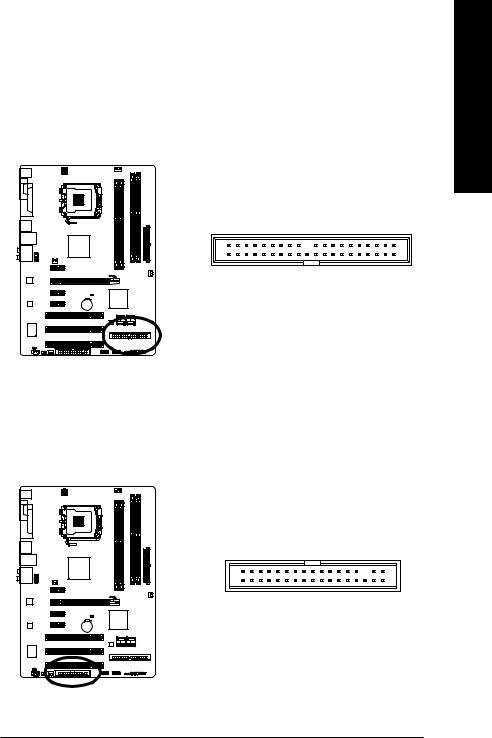
7)IDE1 (IDE Connector)
An IDE device connects to the computer via an IDE connector. One IDE connector can connect to one IDE cable, and the single IDE cable can then connect to two IDE devices (hard drive or optical drive). If you wish to connect two IDE devices, please set the jumper on one IDE device as Master and the other as Slave (for information on settings, please refer to the instructions located on the IDE device). Before attaching the IDE cable, please take note of the foolproof groove in the IDE connector.
2 |
40 |
1 |
39 |
English
8)FDD (FDD Connector)
The FDD connector is used to connect the FDD cable while the other end of the cable connects to the FDD drive. The types of FDD drives supported are: 360KB, 720KB, 1.2MB, 1.44MB and 2.88MB. Before attaching the FDD cable, please take note of the foolproof groove in the FDD connector.
33 |
1 |
34 |
2 |
- 21 - |
Hardware Installation |
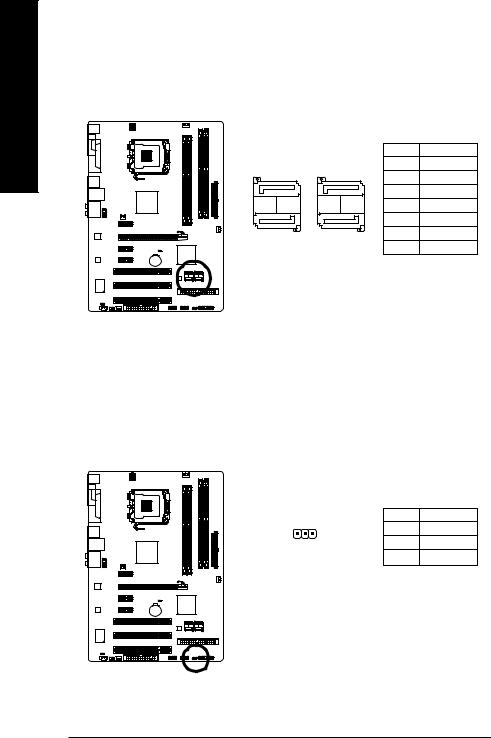
English
9)SATAII0 / 1 / 2 / 3 (SATA 3Gb/s Connectors)
SATA 3Gb/s can provide up to 300MB/s transfer rate. Please refer to the BIOS setting for the SATA 3Gb/s and install the proper driver in order to work properly.
|
|
|
|
Pin No. |
Definition |
|
SATAII0 |
|
SATAII2 |
1 |
GND |
|
|
2 |
TXP |
||
7 |
1 |
7 |
1 |
3 |
TXN |
|
|
|
|
4 |
GND |
1 |
7 |
1 |
7 |
5 |
RXN |
|
SATAII1 |
|
SATAII3 |
6 |
RXP |
|
|
|
|
7 |
GND |
10)PWR_LED
The PWR_LED connector is connected with the system power indicator to indicate whether the system is on/off. It will blink when the system enters suspend mode(S1).
|
Pin No. |
Definition |
|
1 |
1 |
MPD+ |
|
2 |
MPD- |
||
|
|||
|
3 |
MPD- |
GA-945PL-(D)S3 (rev. 2.0) Motherboard |
- 22 - |
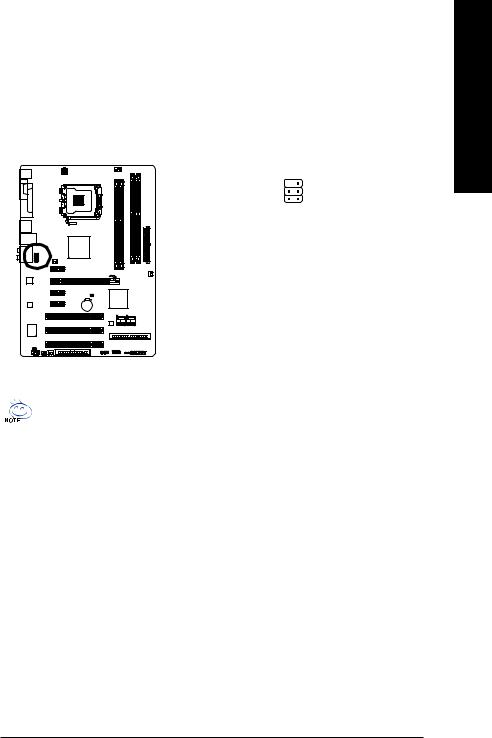
11)F_AUDIO (Front Audio Connector)
This connector supports either HD (High Definition) or AC97 front panel audio module. If you wish to use the front audio function, connect the front panel audio module to this connector. Check the pin assignments carefully while you connect the front panel audio module. Incorrect connection between the module and connector will make the audio device unable to work or even damage it. For optional front panel audio module, please contact your chassis manufacturer.
10  9
9
2  1
1
HD Audio:
Pin No. |
Definition |
1 |
MIC2_L |
2 |
GND |
3 |
MIC2_R |
4 |
-ACZ_DET |
5 |
LINE2_R |
6 |
FSENSE1 |
7 |
FAUDIO_JD |
8 |
No Pin |
9 |
LINE2_L |
10 |
FSENSE2 |
AC'97 Audio:
Pin No. |
Definition |
1 |
MIC |
2 |
GND |
3 |
MIC Power |
4 |
NC |
5 |
Line Out (R) |
6 |
NC |
7 |
NC |
8 |
No Pin |
9 |
Line Out (L) |
10 |
NC |
By default, the audio driver is configured to support HD Audio. To connect an AC97 front panel audio module to this connector, please refer to the instructions on Page 71 about the software settings.
English
- 23 - |
Hardware Installation |
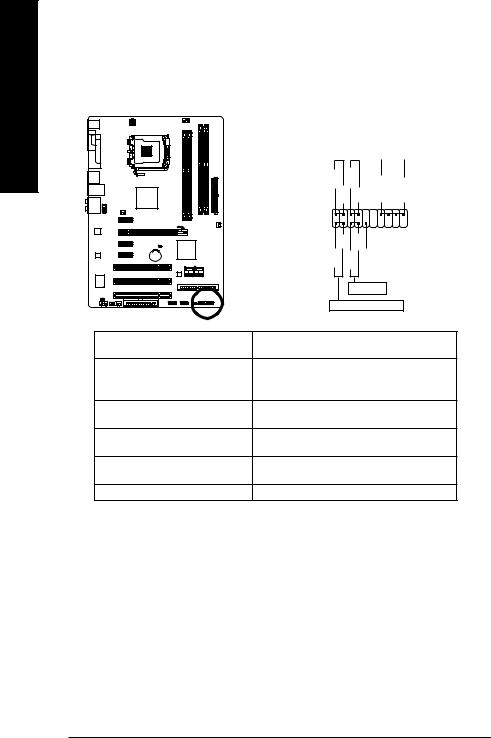
English
12) F_PANEL (Front Panel Jumper)
Please connect the power LED, PC speaker, reset switch and power switch etc of your chassis front panel to the F_PANEL connector according to the pin assignment below.
|
|
|
|
Speaker Connector |
|||
Message LED/ |
|
|
|
|
|
|
|
Power/ |
|
Power |
|
|
|
|
|
Sleep LED |
|
Switch |
|
|
|
|
|
|
|
|
|
|
|
|
|
|
MSG+ MSGPW+ PW- |
SPEAK+ |
SPEAK- |
|
2 |
|
20 |
|
1 |
|
19 |
|
HD+ HDRES- RES+ NC |
|
|
|
Reset Switch |
|
|
|
IDE Hard Disk Active LED |
||
HD (IDE Hard Disk Active LED) |
Pin 1: LED anode(+) |
|
|
(Blue) |
Pin 2: LED cathode(-) |
|
|
SPEAK (Speaker Connector) |
Pin 1: Power |
|
|
(Amber) |
Pin 2- Pin 3: NC |
|
|
|
Pin 4: Data(-) |
|
|
RES (Reset Switch) |
Open: Normal |
|
|
(Green) |
Close: Reset Hardware System |
|
|
PW (Power Switch) |
Open: Normal |
|
|
(Red) |
Close: Power On/Off |
|
|
MSG (Message LED/Power/Sleep LED) |
Pin 1: LED anode(+) |
|
|
(Yellow) |
Pin 2: LED cathode(-) |
|
|
NC ( Purple) |
NC |
|
|
GA-945PL-(D)S3 (rev. 2.0) Motherboard |
- 24 - |
